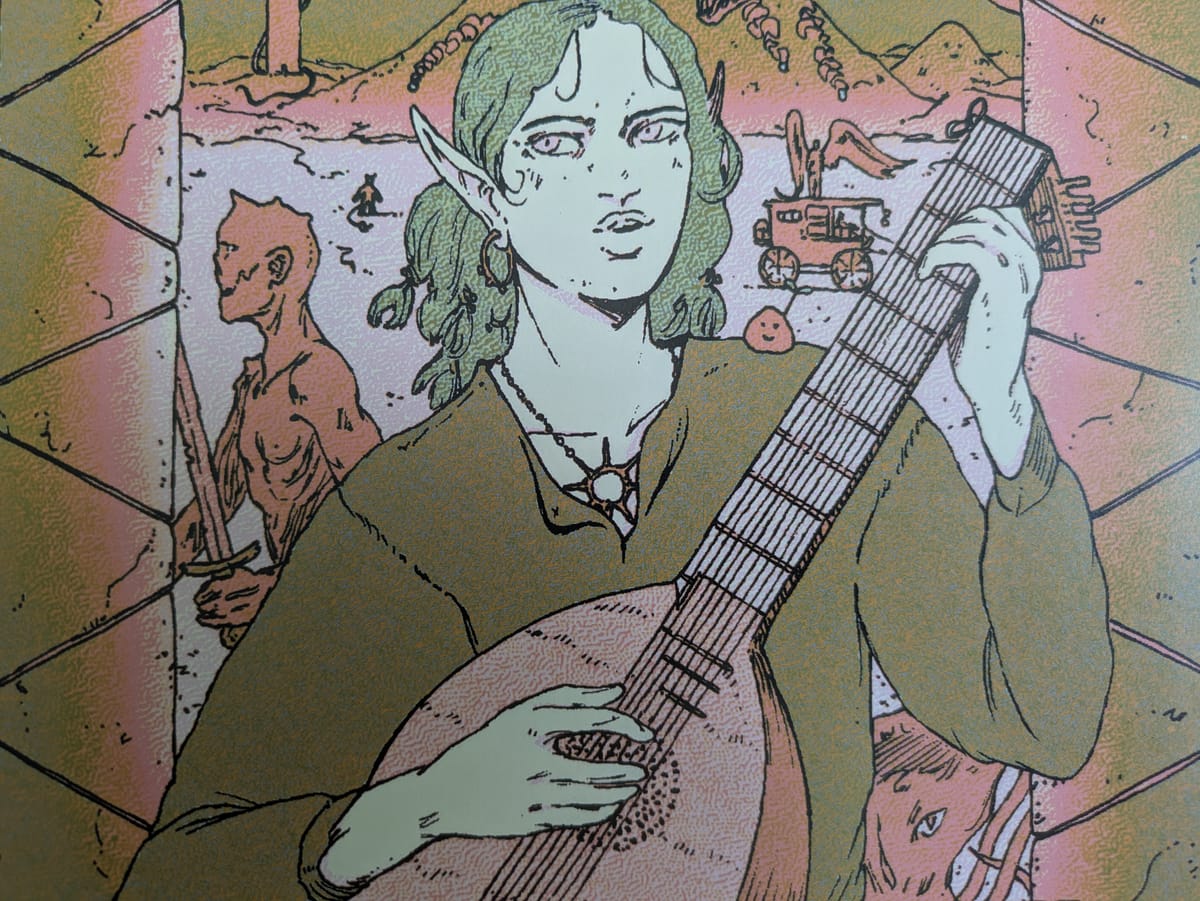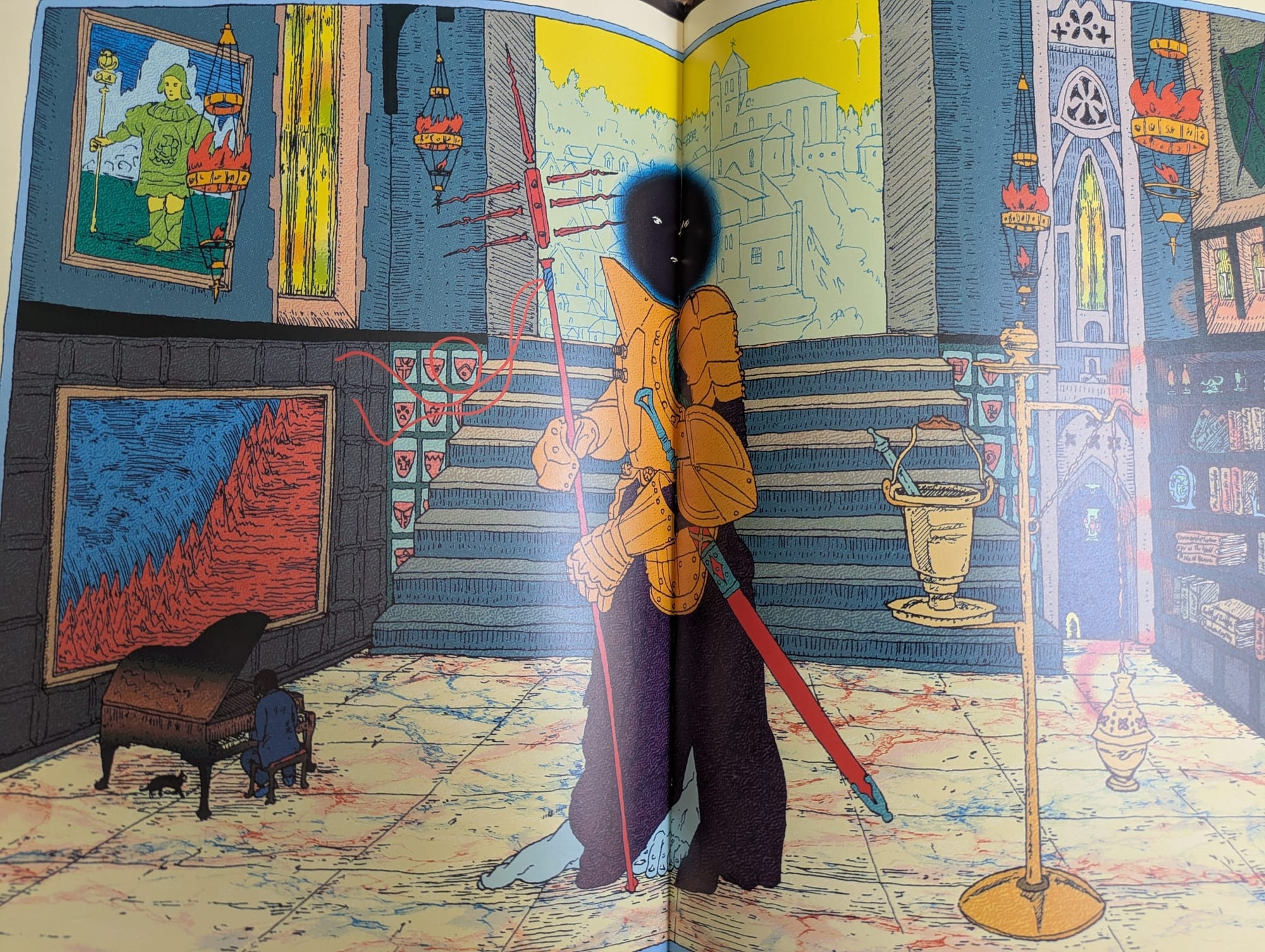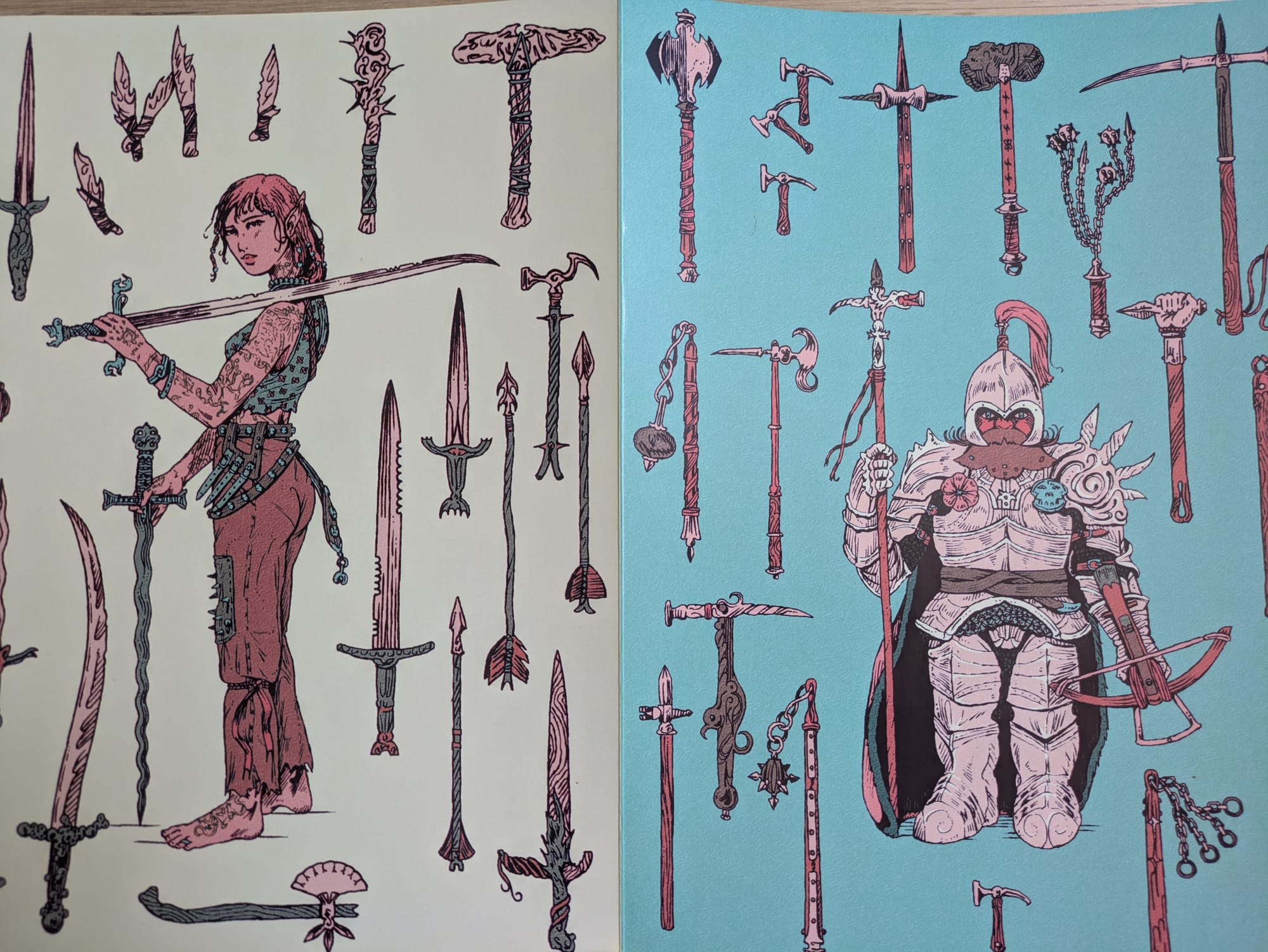
Ballads of Oraed is a beautiful jaunt into a world of fantasy adventure; its pages dripping with theme and inspiration, it brings its world of high magic to life evoking all the best in classic D&D. As a gazetteer of Oraed, it fills you with the warm feeling that you’re reading the storybook dropped from a world not your own. Unfortunately, as an RPG supplement it falls far short. The grandeur of its vision is not matched by the kind of technical detail or presentation that would make it useful at the gaming table. As intriguing as it is conceptually, the layout and presentation don’t measure up to the needs of a gaming supplement.
The book itself is a soft-cover 231 pages. Each chapter has different page colors to ease navigation, and ink drawings on the outside help lend a sense of magical expression. The binding is inconsistent, as each chapter is bound separately. Some sections are fine but others threaten to tear loose faster. Much of the art is full-page portraits or landscapes, and the later 20 pages or so are taken up completely by full color depictions of Oraed’s peoples. Each of these are lovely glimpses into a fantasy world. They make me wish I were a less respectful person, because I have a powerful urge to rip these pages out and put them on a wall somewhere. Many of them would be worthy posters. Their line drawing aesthetic pulls me right back to 80s era fantasy, that early, hazy age when magical worlds were mysterious and dangerous but pouring over with potential to light the imagination on fire.

The 14 chapters (one of which is that section of art) open with an atlas and map of Oraed, with a general discussion of the setting and major characters. It moves onto discussing sailing, with notes on weather, ships, and crews. Broken up by a short comic, we then have a series of adventures and a bestiary with art of each antagonist. Within these stories are some unique, fascinating ideas of things to add to a fantasy world. A giant sentient cloud vampire that rules the land, sometimes disguising itself as swarms of animals. Factions vying against one another with many ways for the players to influence them. A board game for PCs, a river of poison dripping from a magical beast’s tail, ships with fascinating lore baked into their visual designs and their very names.
Reading this book, you feel yourself descending into another world, glimpsing the history of a place that you might just reach. The art, the prose, the maps, and the creatures depicted within pull you into a place conceived as if in a bygone age. Another time when fantasy games were beginning to bloom into full force, with no limitations or quality control. There’s a raw energy to this book that makes it attractive as an art piece, but nigh-unusable for RPGs. Before I get into the details of how it falls short, I can talk about the best, most useful part of Ballads at the table: the GM screen.

The screen is three panels of information. The sides facing the players portray the best of Oraed’s strengths: detailed character art full of personality and history, surrounded by the many weapons used in the setting. A glance will inspire you, and invite you to become entranced, seeking more of the setting. The interior has a section of general rules summaries for travel, combat, checks, equipment, and other key reference points. OSE is a good game, but one with many details to keep in mind, and this screen helps put the most important ones right in front of you. It also contains sample names for many races, encounter tables, and a breakdown of the various deities. This is a tool that could be used for games outside of this setting, with its breadth of useful information. Here, more than anywhere else, Ballads of Oraed knows how to make itself accessible.
The problem comes in everywhere else. The art and writing show off many strengths, but not the way those things are presented. I’ve harped on this point many times in my reviews, and the industry shows no signs of letting me stop: RPG books are not normal books. They need to function as tools for the reader while prepping the adventure and running it. Ballads of Oraed spends far too much of its time dumping information at you, with little to no organization or emphasis to help you navigate. Details of lore and locations are thrown into a blender with character motivations, developments in the plot, and tools for the GM. Sometimes the art pieces are connected to this information, like a map or character. Sometimes it’s just more flavor.

Rarely are key terms or developments bolded or highlighted in any way that would make them stand out. Common, bafflingly, are sections of the text center justified. This often includes monster stats, making it all difficult to parse. Sometimes a page will be overflowing with information, sometimes it will be one sentence or paragraph. The only way to make this usable is to read through the entire thing, maybe more than once, and then to functionally rewrite it with your own notes.
There’s little in the way this is laid out that would help clue you in to how things are supposed to happen, or how locations relate to each other. Very often the mix of typesets and layout, with no rhyme or reason, feel like a first draft that was placed into the text without follow-through.

There’s no question that writer/artist Jean DeMers has talent. His art, his ideas, and his moment to moment writing have too much going on for me to want to dismiss his potential, or what he has to contribute to the RPG scene. But those talents need to be paired with someone of more boring talent, who knows how to cut and present this information in a way that makes it usable for GMs. I like a lot of what I see here; while reading through it, you can’t help but be inspired by the vision. Even if it’s built on the fairly standard chassis of a D&D fantasy world with elves and orcs and goblins, it leans into those features to remind us how much charm you can find when you accept the magic for what it is.
Ballads of Oraed
Mediocre
Ballads of Oraed is a beautifully illustrated and thematically rich journey into a classic-style fantasy world, bursting with creativity and evocative storytelling. Its vibrant setting and visual style recall the early days of tabletop RPGs, with a nostalgic charm that will inspire many readers. However, as a game supplement, it falters—its lack of structure, unclear formatting, and disorganized presentation significantly hamper its usability at the table. While Jean DeMers’ artistic vision is undeniable, it needs editorial input to become a functional tool for game masters.
Pros
- Mystical, classic Visuals and Art Design
- Rich Worldbuilding
- Useful GM Screen
Cons
- Poor Layout and Usability
- Lacks Game-Ready Content
- Inconsistent Formatting
This review is based on a retail copy provided by the publisher.
